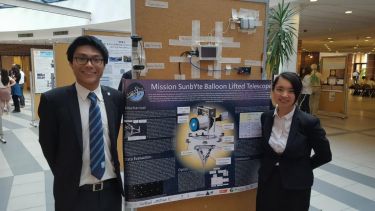The Sheffield University Nova Balloon Lifted Solar Telescope (SunbYte) project – a purpose built telescope attached to a Nova Balloon – was successfully launched 30km above the Earth to capture images of the sun without atmospheric disturbances in October 2017. The observational facility was the first of its kind to be built from scratch by a team of more than 30 UK students.
The team grabbed the attention of conference delegates. They showcased the background, methodology and lessons learnt on the German-Swedish REXUS/BEXUS programme, as well as an exploded view of the main gimbal design using Solidworks CAD software.
Supplementing the presentation of a project poster, the BEXUS team leader, Yun-Hang Cho (the University of Sheffield), delivered a one minute pitch to bring the delegates up to speed with the technology and technicalities of the project.
The electronics team leader Gianni Sin Yi Heung (University of Hong Kong) went on to demonstrate this new concept for High Altitude Student Platform (HASP) missions. He replicated the key components of the electronic design in a flat pack manner on the wall, giving conference delegates a hands-on experience.
The team is now looking forward to Gianni’s visit to Sheffield, where she will train the new electronics team members and participate in a concurrent engineering design session to study alternative gimbal designs according to HASP flight requirements.
SunbYte academic leads Dr Viktor Fedun, from the Department of Automatic Control and Systems Engineering (ACSE), and Dr Gary Verth, from the School of Mathematics and Statistics (SoMAS), thanked the continuing support of the University of Sheffield’s Alumni fund which has helped the project monumentally.
The collaboration within the University of Sheffield, especially in the Faculty of Engineering, has provided our students with this great opportunity to showcase their work and give them invaluable experience. The project would not have been possible without the ongoing support and expertise of ACSE, SoMAS, Institution of Mechanical Engineers, the European Space Agency, and REXUS/BEXUS.
Dr Viktor Fedun
Department of Automatic Control and Systems Engineering

